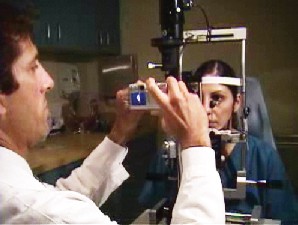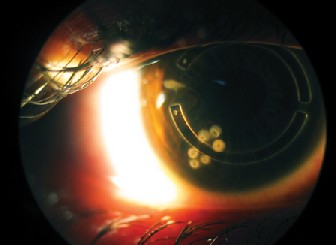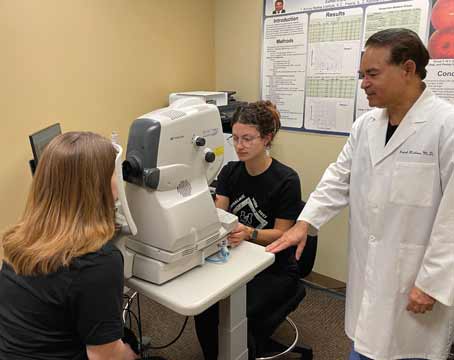 |
| Dr. Davidorf recommends a camera with a lens that fits into the ocular of the slit lamp. |
"I do a lot of talks and articles that need illustration, and interesting patient presentations are always coming through the door," Dr. Davidorf says, "but I didn't have a good imaging system. I looked into how I could get a quality system, and found you can get a non-digital camera that hooks onto a slit lamp, but it's bulky and you can't tell the quality of your picture until it's developed. Or, you can go with a digital system, but it's expensive, and it might not be compatible with your slit lamp."
As an alternative, six months ago he began using his small Canon S45, 4-megapixel digital camera to take pictures at the slit lamp and, he says, "The images have been wonderful."
To use the camera at the slit lamp with the slit beam on, he turns off the flash and puts it in macro mode, adjusting the camera's zoom and the slit lamp's magnification as desired. He uses his left hand to work the slit lamp's joystick, and holds the camera with his right. He gets the view in focus, then puts the camera up to one of the oculars of the slit lamp so he can then view the eye through the camera's viewfinder. He then takes the picture.
 |
| A patient with Intacs and CK for keratoconus, shot by the digital camera. |
"Anything in the anterior segment is pretty easy to capture," he says. "You can also do sclerotic scatter. For that, disable the flash and have an assistant shine a muscle light onto the sclera, and you can take a picture of something like a pterygium.
"There are some gymnastics involved in that I've got to use both hands to do it, but anyone who can use both hands to do a phaco can do this," he says.
There's always room for improvement, however. "It would be great to have an adapter that held the camera at the ocular of the slit lamp, and a footswitch to release the digital shutter. This would not only make it easier for anterior photography, but you could also do posterior photography through a 90-D retina lens … or even with a fundus contact lens. You need an extra hand for those."
Currently, Dr. Davidorf says he's looking into getting a second camera, but not for work.
"Right now this camera travels with me between home and the office," he says. "So, when I'm at work, we're missing some good shots of the kids playing with my wife!"
To see Dr. Davidorf's video on this topic, go to
http://www.revophth.com/index.asp?ArticleType=SiteSpec&page=rp_video.htm





